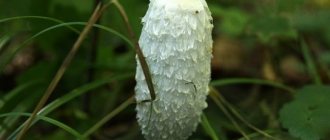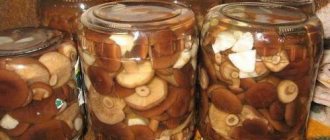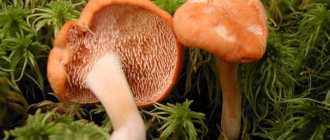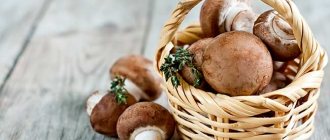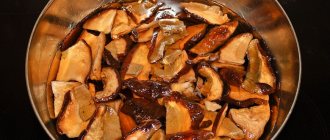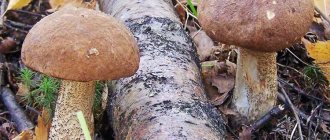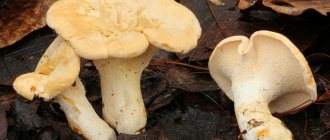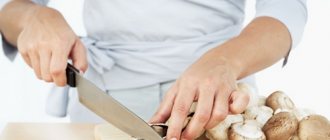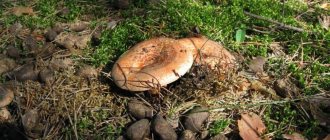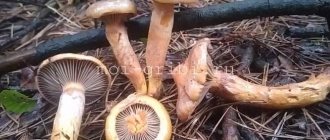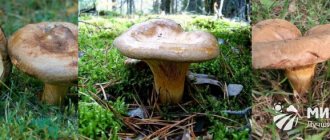Pickled milk mushrooms are the best preparation option for preparing these amazingly tasty and nutritious gifts of the forest. Thick crispy flesh and subtle mushroom aroma will become a real highlight of the table. After all, when pickled, these mushrooms are most often served as an independent dish, with potatoes being the best side dish.
Traditional Russian fermented milk mushrooms are prepared hot or cold. To cook mushrooms correctly, you should familiarize yourself with the features of the process and the step-by-step recipe.
Features of the process depending on the type of product
Each mushroom has its own characteristics in pickling. Mushrooms that do not need to be soaked :
- Hedgehogs.
- Saffron milk caps.
- Russula.
- Rows.
- Goats.
Some types of mushrooms can be salted together , for example:
- Milk mushrooms.
- Volnushki.
- Russula.
- Saffron milk caps.
- Loadings.
Some mushrooms are boiled , for example:
- Serushki.
- Volnushki.
- Bitter milk mushrooms.
- Chernushki.
- Violins.
For cold fermentation without soaking, the following mushrooms are used :
- Boletus mushrooms.
- Butter.
- White mushrooms.
- Talkers.
- Saffron milk caps.
- Chanterelles.
- Russula.
For fermentation with pre-soaking, take the following mushrooms :
- Burning russula.
- Bitter milkies.
For hot fermentation use:
- Russula.
- Rows.
- Bitter milk mushrooms.
- Honey mushrooms.
- Tubular mushrooms.
- White mushrooms.
Preliminary preparation
The preparation of valuevs must certainly begin with the preliminary preparation of the fruiting bodies. It allows you to improve the nutritional and taste qualities of the product, remove the milky juice, which gives the mushroom bitterness, and rid it of harmful substances.
Processing values begins with cleansing. To do this, the freshly harvested crop is sorted, spoiled specimens are removed, then placed in a container and filled with cold water so that the fruits are completely covered with water. The liquid should be salted: take 1 tsp. salt per 1 liter of water. Next, you need to place a weight on top (a plate turned upside down), place a bottle of water or another heavy object.
Soaking should last at least a day, preferably 2–3. Twice a day you need to change the water and add fresh water. Mushrooms should be washed.
The next step is digestion:
- Soaked and washed valui are placed in boiling water.
- You need to cook for 10 minutes over medium heat.
- Drain in a colander and repeat the digestion process twice more.
- The last time you need to cook the gobies until the fruiting bodies sink to the bottom.
- Only after all these manipulations have been carried out can the mushrooms be prepared further in accordance with the recipe.
Preparation with cabbage
We'll tell you how to ferment mushrooms and cabbage.
Ingredients:
Three kilograms of cabbage.- 0.25 kilograms of carrots.
- 0.3 kilograms of apples.
- One kilogram of mushrooms.
- Four tablespoons of salt.
Cooking method:
- Wash and chop the mushrooms.
- Chop the cabbage.
- Peel the carrots and grate them.
- Remove the core and cut the apples into small pieces.
- Place cabbage and apples alternately in a wooden container, and carrots and mushrooms between them.
- Cover with cabbage leaves, pour in brine and press down.
- Put oppression on top.
- Make sure the cabbage is covered with brine.
Here's how to ferment mushrooms and cabbage.
Pickling as an alternative to marinade
During the harvesting season, salt and sugar turn from strategic products into tactical ones: kilograms of them are “spent” on jams and pickles. Another equally popular ingredient among housewives when canning at home is vinegar. As you know, microbes do not survive in an acidic environment. Therefore, when canning, organic acids are used - vinegar, citric acid.
Acid is different from acid
But excessive acidity is dangerous not only to harmful microorganisms, but also to beneficial ones, for example, the microflora of our stomach. Abuse of pickled cucumbers or mushrooms can negatively affect the condition of even a healthy person, let alone those with ulcers. The fermentation process is based on the activity of lactic acid bacteria, the result of which is lactic acid, which becomes a preservative - in the resulting acidic environment, other bacteria do not multiply. And lactic acid is a much gentler option for the stomach than vinegar. Moreover, lactic acid bacteria (genus Lactobacillales) also include representatives of Lactobacillus acidophilus, which are part of the microflora of the stomach of humans and some other mammals and directly affect human life and health. Acidophilic (acid-loving) bacteria are used to produce medications - probiotics (preparations containing live cultures of lacto and bifidobacteria). Preparations containing cultures of lactic acid bacteria are used for gastrointestinal disorders, treatment of diarrhea, and to strengthen and enhance immunity. This means that lactic acid is more beneficial than acetic acid in canning.
Digression about vinegar
To be fair, it is worth noting that vinegar is also not only a popular seasoning, but also a medicine - it is an excellent antiseptic, and is used to fight various infections. However, this applies only to natural vinegar - a product of ethyl alcohol oxidation by acetic acid bacteria: grape, apple, rice, malt and others. Synthetic acetic acid is produced not by acetic acid bacteria, but by chemists - in one of the industrial production methods, synthetic acetic acid is a by-product in the production of fertilizers.
But do all housewives have a bottle of apple cider vinegar in their cupboard, and natural one, and not the same aqueous solution of synthetic acetic acid with the same chemical “Apple” flavoring? On culinary forums, recommendations are given on how to dilute vinegar essence to obtain 6-9% table vinegar, and many recipes directly indicate how much undiluted vinegar essence should be taken for a given volume when preparing a marinade. Meanwhile, in many countries the use of vinegar essence for food purposes is prohibited. And the taste of vegetable salads, cucumbers or mushrooms with synthetic vinegar marinade deteriorates during storage: the acid neutralizes the taste of the dish, erasing it.
Pickling and urinating
Strictly speaking, today there is no difference between pickling and pickling: salt is also used for pickling. Therefore, with this method of canning, two preservatives are used - salt and lactic acid. The classic recipe for pickled cucumbers includes a fermentation stage. It is customary to distinguish salty canned foods by the concentration of salt in the solution:
- 6-8% and more - pickles;
- 2.5-3% - fermented product;
- 1-2% salt and sugar added to the solution - urine.
Traditionally, cucumbers are considered pickled, cabbage is sauerkraut, and apples are pickled. Although our ancestors fermented cabbage, cucumbers, and mushrooms without using salt, salt was expensive. Proponents of a healthy diet, such as Paul Bragg, also advise not to use salt when fermenting, for example, cabbage.
Several quick recipes for dishes with pickled mushrooms
But what delicious dishes can be prepared from pickled mushrooms.
Casserole with meat
Ingredients for the dish:
0.5 kilograms of veal or pork.- One jar of mushrooms with a volume of 500 milliliters.
- One onion head.
- Vegetable oil for frying.
- 0.2 liters of twenty percent cream.
- 0.15 kilograms of Gouda cheese.
- Salt and pepper to taste.
Cooking method:
- Chop and fry the onion in oil until light brown, then add the mushrooms to the pan and fry them a little, stirring the mushrooms and onions.
- Add cream and mix everything well again. Close the pan with a lid. Cook over low heat for four minutes.
- Cut the cooked meat and place it in a baking dish. In this case, the mold must be greased with oil and salt. Pour the sauce of mushrooms, cream and onions over the meat in the form, and then add grated cheese.
- Bake at 200 degrees Celsius in a pan covered with foil for 25 minutes. Next, remove the foil and keep in the oven for another ten minutes until golden brown. You can add fresh vegetables to the prepared dish.
The vinaigrette
Ingredients for the dish:
One large boiled beet.- Three boiled potatoes.
- One boiled carrot.
- Three pickled cucumbers.
- Half a can of canned peas.
- Half an onion.
- 0.2 kilograms of pickled mushrooms.
- Three tablespoons of vegetable oil.
- Pepper and salt to taste.
Cooking method:
- Wash the beets, but do not peel them, wrap them in foil and bake in the oven at 200 degrees Celsius until fully cooked.
- Wash carrots and potatoes and cook in water with salt until soft.
- Next, pour out the water and wait for the vegetables to cool, peel them.
- Chop all vegetables except onions into cubes of the same size. Just chop the onion.
- Mix everything and add a little salt.
- Add green peas and pickled mushrooms to the vegetables, then pour in the oil and stir.
Below is a video with a visual example of another recipe for making a vinaigrette with mushrooms:
A little theory
Throughout human history, the need to increase the shelf life of food has been a vital issue. Given the current state of the food industry in developed countries, of course, its ability to survive no longer depends on whether a family can stock up on provisions for the winter.
However, canning, including homemade, is still relevant. Despite the development of technology, only four fundamental principles of food preservation are known:
- bioz - storage of fruits and vegetables without special processing, only when creating conditions that support normal life processes in fruits, limiting their intensity. Natural resistance to pathogenic microorganisms is used. According to the principle of biosis, potatoes, various root vegetables, pumpkins, etc. are stored in the cellar. In addition to vegetables and fruits, other products, such as bird eggs, are also preserved through biosis.
- suspended animation - storage at low temperatures. In the cold, the activity of bacteria that destroys food slows down, even stopping completely.
- abiosis - the creation of conditions leading to the death of harmful microorganisms. These conditions - for example, high or low temperatures, creation of an acidic environment (pickling), disruption of cellular osmosis - when using salt or sugar, anaerobic (airless) environment. With this method, after destroying microorganisms that lead to food spoilage, it is necessary to ensure the safety of the product from new contamination with microorganisms, that is, place it in a sterile sealed environment.
cenobiosis - this method of preserving food consists of cultivating beneficial microflora, which, through its active development and processes occurring as a result of its vital activity, suppresses the development of pathogenic microbes and bacteria and makes their existence impossible. Cenobiosis includes fermentation and pickling.
All methods of canning, used both on an industrial scale and for home preparation, are in one way or another based on these four principles or their combinations.
Problems and difficulties
In the first week, the temperature should be between 15 degrees and 20 degrees Celsius.
Attention! At high temperatures, yeast and acetic bacteria will appear, and at low temperatures, molds will appear.
The selection of spices during fermentation seems to be an essential point. Unlike pickling, the selection and ratio of spices during sourdough is a true culinary creativity. The composed composition will make the taste of pickled mushrooms unique.
Can they be stored at home?
You can store pickled mushrooms not only on the balcony and in cellars, but also at home , for example:
in enamel buckets, which are best suited for fermentation;- in barrels;
- in pans;
- in tubs;
- in glass jars.
All containers for pickled mushrooms must be boiled and dried; as for jars, they should be sterilized. Store in a cool place.
To prevent pickled mushrooms from freezing on the balcony or in the cellar, storage boxes must be insulated. High temperature - the mushrooms will sour, and low temperature - the mushrooms will become brittle and soft, and will also lose their taste.
Once every seven days you need to shake the mushrooms to move the brine . Cooled boiled water should be added when half of the brine has disappeared.
Salted honey mushrooms for the winter. Hot and cold cooking recipes
We continue the series of articles about mushroom preparations for the winter. In previous articles, we got acquainted with the methods of pickling honey mushrooms. Now I will review recipes for making salted mushrooms. If you have not yet picked mushrooms this year, then hurry up, as with the onset of cold weather they will no longer be available.
It is important to note that honey mushrooms cannot be stored for a long time without processing, so they must be salted immediately after returning from the forest. They need to be sorted out, wormy and broken mushrooms should be discarded, and if possible, select ones of the same size
Today we will look at two ways to prepare winter snacks: hot and cold. The latter is considered a classic, but it takes more time.
So, let's start reviewing the recipes...
Hot salted honey mushrooms in 1 or 2 liter jars
This option for preparing a mushroom appetizer from honey mushrooms is the simplest and safest. After this treatment, the mushrooms can be stored for one year.
Ingredients:
- 2 kg of fresh honey mushrooms.
- 12 bay leaves.
- 60 g table salt.
- 10 cloves of garlic.
- 3 dill umbrellas.
- 10 peas of allspice.
For brine per 1 liter of water:
- 3 pieces of bay leaves.
- 7 pcs cloves.
- 7 black peppercorns.
Cooking process
Small mushrooms are better suited for pickling. If you have collected large wild mushrooms, you will have to cut them into several parts. First you need to carefully sort through, clean well of dirt and rinse 2-3 times.
For large honey mushrooms, we separate the stems from the caps, and small mushrooms can be harvested whole. Place in a large container, fill with running water and salt it. Place on the burner, and after the liquid boils, cook for no more than five minutes. The resulting foam must be removed.
Rinse the cooked mushrooms in a colander and leave to drain all the liquid. Then transfer them to a separate bowl.
Peel the garlic and cut into small slices. Place dill umbrellas in enamel containers.
Then lay out a small layer of mushrooms, add salt and the necessary spices. Lay out several layers in the same way, and pour the prepared brine (1 cup) on top.
Cover the mushrooms with a plate and place a load on top (a saucepan or a jar of water). Under pressure, the mushrooms should be completely immersed in the brine. If there is not enough liquid, you will need to add a little.
If you do not have a cellar, then it is better to store the snack in the refrigerator. But after a year, it is not recommended to eat them, as salted mushrooms can cause food poisoning or illness.
Cold salted honey mushrooms in jars
If you want the mushroom appetizer to be aromatic and crispy, then it is better to use a cold cooking method. This will just take a lot of time, so be patient.
Ingredients:
- 1 bucket of honey mushrooms.
- Garlic.
- Dill umbrellas.
- Horseradish leaves.
- Black peppercorns.
- 200 g table salt.
Salting method
The honey mushrooms need to be cleaned and the stems cut off; since they are hard, we will not use them. Soak the caps in salted water for 3 days. This procedure allows you to get rid of the bitter taste.
Renew the water daily, otherwise the honey mushrooms will spoil. It is advisable to soak the mushrooms in a wooden barrel, but if you do not have this opportunity, you can use a plastic bowl or large saucepan.
Add washed horseradish leaves and chopped root to a wooden tub. If desired, you can use cherry or currant leaves. Add chopped garlic, dill umbrellas and peppercorns. Then lay out a layer of mushrooms, which need to be salted.
Thus, you need to lay out several layers. Then you need to install oppression on top. Place honey mushrooms in a cool and dark place for 2 months. Periodically you need to check whether the snack has spoiled.
It is recommended to store salted mushrooms in the cellar. If you do not have this opportunity, then put them in the refrigerator. Before use, it is recommended to add onion rings and vegetable oil to honey mushrooms.
Other methods of harvesting mushrooms
- Freezing. It retains its beneficial properties.
- Boil and freeze. This way the mushrooms will last for a year.
- Pickle the mushrooms.
- Fried mushrooms in the refrigerator will only be fresh for 24 hours.
- Fried mushrooms in the freezer. Will keep for six months.
- Marinated in a dry cellar. If the lids are tin, then one year, glass - two years.
- Homemade marinated mushrooms. Will last for eight months.
- Drying mushrooms.
- Pickling mushrooms.
In Russia, mushrooms are very popular. A variety of dishes are prepared from them: appetizers, salads, desserts, alcoholic drinks. Pickled mushrooms will be an excellent addition as an appetizer on the holiday table.
Ingredients:
| Mushrooms | 10 kg. |
| Currant sprigs | 0 gr. |
| Umbrella dill | 150 gr. |
| Horseradish root | 1 PC. |
| Garlic | 1 goal |
| Salt | 350 gr. |
| Water | |
| Sugar | 3 tbsp. |
| Serum | 1 glass. |
We invite you to study a simple recipe that will allow you to get excellent pickled mushrooms. To ferment mushrooms at home, they use varieties such as: lactifers, summer honey mushrooms, annular caps, autumn honey mushrooms, chanterelles, boletus and other similar mushrooms with a fleshy fruiting body.
- Step 1
We choose young, intact mushrooms, which are best collected in dry weather. We clean the mushrooms, trim the stems and rinse with cold water. Non-bitter mushrooms should be soaked for several hours, and bitter ones for 1-3 days. In this case, the water needs to be changed every day. Let the water drain.
- Step 2
Place the prepared fresh mushrooms in a glass jar. You can also use wooden utensils. Place the mushrooms caps down, layering each layer with leaves and spices. Layers 5-6 cm thick should be sprinkled with salt. Cover the top with a lid and then with oppression (stone). This will create a brine that will cover all the mushrooms.
- Step 3
After a few days, when the mushrooms have settled, you can add the next portion of seasoned mushrooms. The brine needs to be poured in so that it covers the lid. Fermentation is regulated by means of a stone-oppression, for which its weight should be increased. If even then there is not enough liquid, then you can add clean boiled or salted water (depending on whether salt is needed for these mushrooms or not).
- Step 4
Fermentation of mushrooms takes one to two months. When fermented, mushrooms get rid of bitterness and raw taste. They can be used both raw and for preparing salads or as a side dish for various dishes. In order to speed up fermentation, sugar and whey are added to the mushrooms.
Mushrooms should only be stored in a cool place.
Pickled mushrooms. Step by step recipe
- Porcini mushrooms, chanterelles, boletus mushrooms, honey mushrooms, boletus mushrooms, saffron milk caps and boletus mushrooms are suitable for pickling. Sort the mushrooms, try to pick mushrooms of approximately the same size for pickling. If the mushrooms are large, cut them into pieces.
- Pour water into an enamel pan, add salt and citric acid, bring to a boil, then add mushrooms to the water.
- Cook the mushrooms over low heat until done. The finished mushrooms will completely settle to the bottom of the pan.
- When the mushrooms are cooked, do not forget to stir them and remove the foam.
- When the mushrooms are ready, drain them in a colander, rinse with cold water and let the water drain.
- Prepare the filling. To do this, mix water with sugar and salt and bring to a boil.
- Place the mushrooms in jars, pour boiling liquid over them, cover with lids and leave for three days at room temperature.
Then put the mushrooms in a cold place (cellar, refrigerator). Mushrooms are ready for consumption no earlier than in a month. But it's worth the wait. Delicious!
Recipe author: Mikhail Makarenko
Here you will find such a wonderful recipe for crispy cucumbers.
